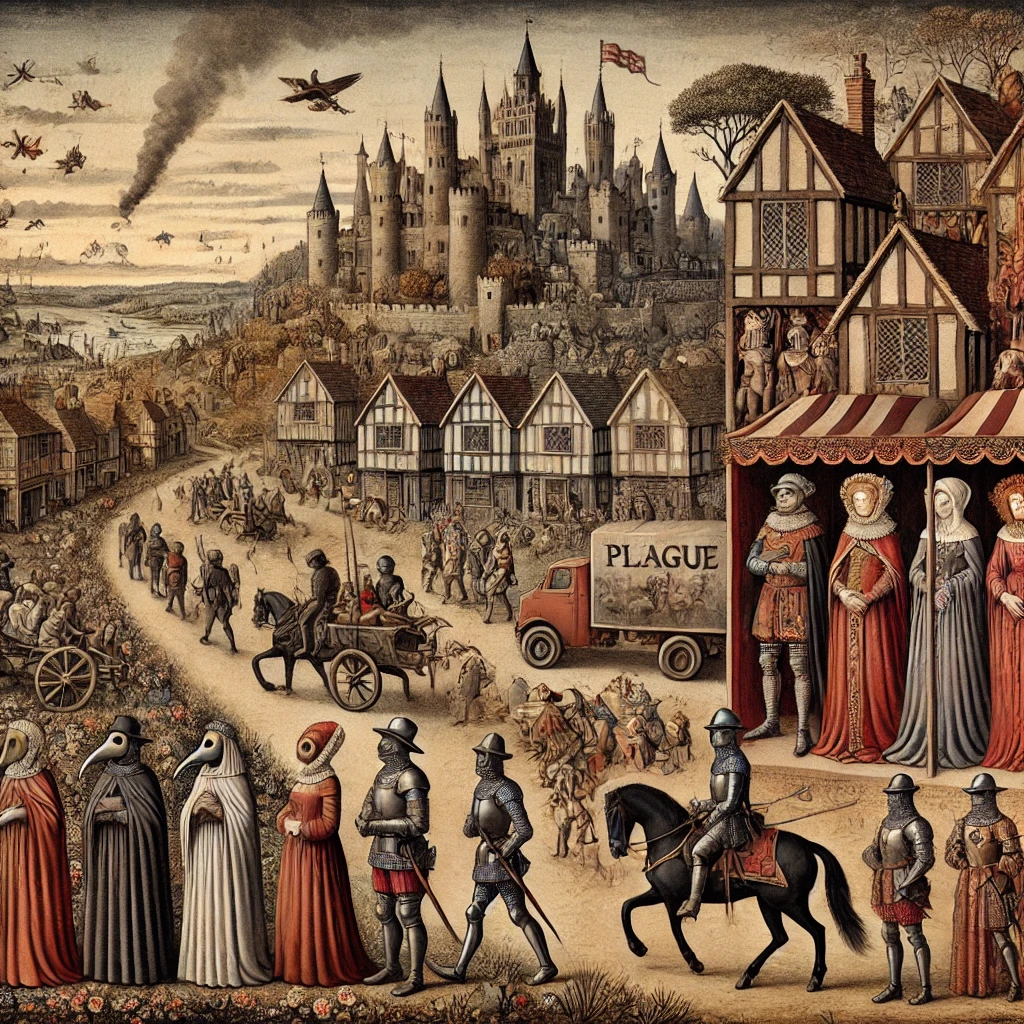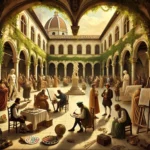By ABS, The Literary Scholar
(Because poetry isn’t the only thing that wore a black cloak in the 1300s)
Imagine living in a time where your to-do list looked something like this:
Avoid the plague
Dodge the Hundred Years’ War
Find a husband before 15
Learn embroidery
Die
Welcome to 14th-century England, where life was short, laundry was a luxury, and people still found time to write brilliant poetry, dress extravagantly, and invent passive-aggressive religious pilgrimages.
This isn’t just a dusty history lesson. It’s a chaotic, dramatic, plague-ridden, silk-sleeved soap opera of a century—and we’re diving right into it.
I. First, the Plague (Because Why Not Start With a Bang?)
The Black Death, a.k.a. the original unwanted houseguest, arrived in England in 1348 and by 1350 had killed somewhere between one-third to half the population.
Let that sink in.
No vaccines. No memes. Just rats, panic, and very bad smells.
“A plague on both your houses!” — Shakespeare, being retroactively topical
Symptoms?
Swollen lymph nodes (called buboes—yes, even the symptoms were cute-sounding)
Fever, vomiting, confusion
A quick descent into either death or superstition
People thought it was caused by:
Bad air
God’s wrath
Astrology
Fashion choices (probably)
Meanwhile, the poets?
They wrote disease-fueled allegories and apocalyptic dream visions, because that’s how 14th-century creatives processed trauma.
(Spoiler: it was not through therapy.)
II. War Was Just the Background Music
The Hundred Years’ War (which, fun fact, lasted 116 years) was in full swing.
Why?
Because England and France couldn’t decide who had the better crown, language, or cheekbones.
The result?
Knights writing poetry between battles
Nobles collecting ransom like it was Pokémon cards
Peasants paying taxes for wars they didn’t start
(Some things never change.)
And yes, literature noticed.
The chivalric code became a poetic fantasy. Epic romance mixed with battlefield bloodshed.
“In love and war, all’s fair.” — A proverb probably written by someone with a sword and an unfinished sonnet
III. Fashion: Slay or Be Slain (Literally)
Now, you’d think with all the death and destruction, people would dress modestly, right?
Wrong.
The 14th century saw the birth of fashion drama.
For women:
Long flowing gowns with trailing sleeves
Tight-fitting bodices
Headgear so elaborate it could double as scaffolding
For men:
Tightly tailored tunics
Pointy shoes (sometimes so long they had to be tied to the knees!)
Codpieces started… appearing
Fashion wasn’t just about vanity—it was a power move.
Wearing imported fabric was the medieval equivalent of saying, “I summer in Italy.”
And sumptuary laws tried to stop people from dressing “above their station”—which, naturally, made them want to do it more. Because when has “Don’t do this” ever worked?
IV. Literature: Surviving the Century with Rhyme and Ridicule
This was Chaucer’s century, and poetry didn’t just survive the chaos—it thrived in it.
Poets were writing about:
Love and betrayal
Class tensions
The absurdity of life
And yes, very pointed critiques of the Church
“If gold rust, what shall iron do?” — Chaucer, The Parson’s Tale
(Translation: If priests are shady, what hope for the rest of us?)
Chaucer gave us a cross-section of society in The Canterbury Tales, including:
corrupt friars
lovelorn squires
chatty wives
and millers who fart in people’s faces as revenge
It was a literary circus—and everyone was invited.
V. Women in the 14th Century: Power in Piety and Poetry
Despite patriarchal norms, women weren’t silent.
Many became nuns, abbesses, and mystics, with surprising spiritual authority
Julian of Norwich wrote one of the first books in English by a woman: Revelations of Divine Love
The Wife of Bath (fictional but iconic) redefined womanhood through bold sexuality and verbal dominance
“Experience, though noon auctoritee… is right ynogh for me.”
Translation: Don’t quote dead men to me, I lived it.
Mic. Drop.
VI. The Church: Rich, Powerful, and Kinda Sketchy
The Church in the 14th century had:
Money
Land
Influence
And a growing PR problem
With the plague wiping out priests and monks, many untrained replacements stepped in.
Cue the rise of corruption, indulgences, and religious satire.
“Greed is the root of all evil,” said the Pardoner—right before charging you for fake relics.
Religious poetry became a space for both devotion and protest.
VII. Peasants Revolted—And Not Just in Smell
In 1381, the Peasants’ Revolt erupted. Fed up with:
taxes
unfair laws
and the literal stench of injustice
Led by Wat Tyler and immortalized in sermons and songs, the peasants stormed London, demanded reforms, and for one shining moment… believed.
The rebellion failed, but the poetic spirit of rebellion lived on—especially in literature that questioned authority, hierarchy, and divine right.
VIII. So… What Did This Chaotic Century Leave Us?
Despite pestilence, war, and questionable hygiene, the 14th century gave us:
A literary foundation for modern English
Iconic characters who still feel real
A sarcastic, biting, deeply human look at medieval society
And a reminder that even in the darkest times, humans tell stories—and throw shade
“Time and tide wait for no man.” — Old English proverb
But clearly, fashion, politics, and poetic sass did.
Final Thoughts from ABS: Why We Love This Century
The 14th century wasn’t subtle.
It was loud. Messy. Divine and decadent.
It gave us poetry in plague time, jokes in monasteries, and shoulder pads before the 1980s.
In short: it was kind of iconic.
And that, dear reader, is why it deserves a seat at The Scholar’s Scroll table—coughing, scheming, rhyming, and absolutely fabulous.
Even in chaos, poetry hemmed the edges of life.
ABS straightens the parchment corners, blows out the candle, and fades into the ink of forgotten pages.
Even in chaos, poetry hemmed the edges of life.
Signed,
ABS, The Literary Scholar
A.K.A. One Who Thinks the Renaissance Was Basically a Reboot with Better Fonts and Fewer Leeches
Share this post / Spread the witty word / Let the echo wander / Bookmark the brilliance


